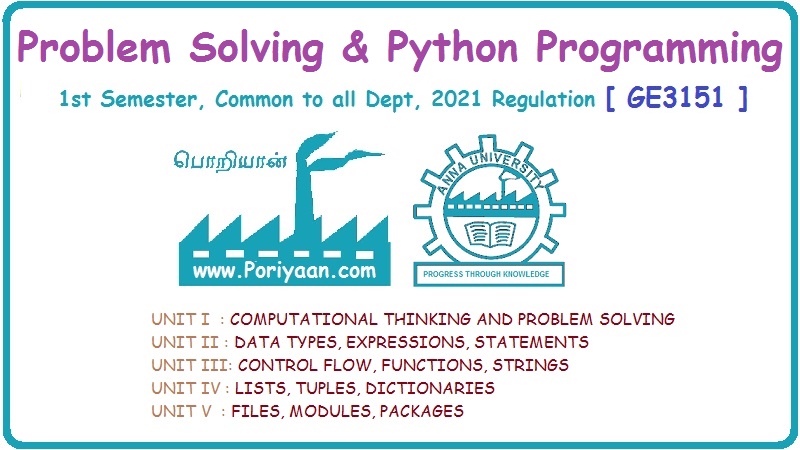Problem Solving and Python Programming: UNIT IV: Lists, Tuples, Dictionaries
Dictionaries
Python Programming
Definition : In Python, dictionary is unordered collection of items. These items are in the form of key-value pairs.
Dictionaries AU
: Jan. 18, Dec.-19, Marks 12
Definition
:
In Python, dictionary is unordered collection of items. These items are in the
form of key-value pairs.
•
The dictionary contains the collection of indices called keys and collection of
values.
•
Each key is associated with a single value.
•
The association of keys with values is called key-value pair or item.
•
Dictionary always represent the mappings of keys with values. Thus each key
maps to a value.
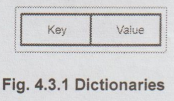
Fig.
4.3.1 Dictionaries
How
to Create Dictionary ?
•
Items of the dictionary are written within the {} brackets and are separated by
commas
•
The key value pair is represented using : operator. That is key:value
• The keys are unique and are of immutable
types - such as string, number, tuple.
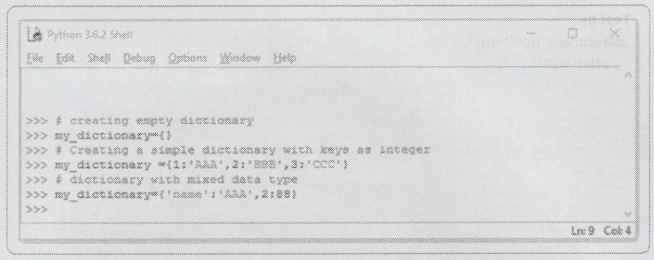
•
We can also create a dictionary using the word dict( ). For example –
>>>
my_dictionary = dict({0:'Red', 1:'Green',2:'Blue'))
How
to access the elements in dictionary ?
We
can access the element in the dictionary using the keys. Following script
illustrates it
test.py
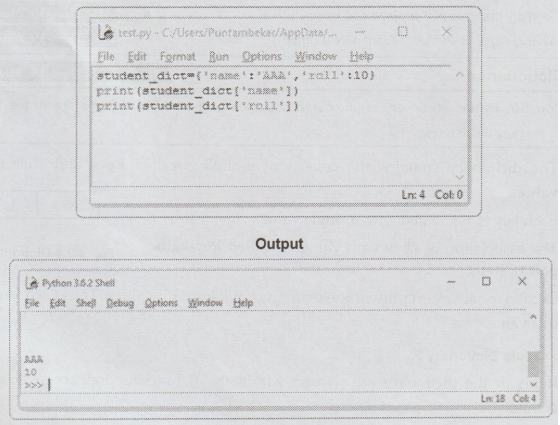
1. Operations and Methods
Basic
operations
Various
operations that can be performed on dictionary are :
1.
Adding item to dictionary
We
can add the item to the dictionary.For example
>>>
my_dictionary = dict({0:'Red', 1:'Green',2:'Blue'})
>>>
print(my_dictionary)
{0:
'Red', 1: 'Green', 2: 'Blue'}
>>>
my_dictionary[3] = 'Yellow' #adding the element to the dictioary
>>>
print(my_dictionary)
{0:
'Red', 1: 'Green', 2: 'Blue', 3: 'Yellow'}
>>>
2.
Remove item from dictionary
For
removing an item from the dictionary we use the keyword del. For example
>>>
del my_dictionary[2] #deleting the item from dictionary
>>>
print(my_dictionary) #display of dictionary
{0:
'Red', 1: 'Green', 3: 'Yellow'}
>>>
3.
Updating the value of the dictionary
We
can update the value of the dictionary by directly assigning the value to
corresponding key position. For example -
>>>
my_dictionary = dict({0:'Red', 1:'Green',2:'Blue')) #creation of dictionary
>>> print(my_dictionary) #display
of dictionary
{0:
'Red', 1: 'Green', 2: 'Blue'}
>>>
my_dictionary[1]='Yellow' #updating the value at particular index
>>>print(my_dictionary)
#display of dictionary
{0:
'Red', 1: 'Yellow', 2: 'Blue'} #updation of value can be verified.
>>>
4.
Checking length
The
len() function gives the number of pairs in the dictionary. For example
>>>
my_dictionary=dict({0:'Red', 1:'Green',2:'Blue'}) #creation of dictionary
>>>
len(my_dictionary) # finding the length of dictionary
3
#meaning - that there are 3 items in dictionary
>>>
Methods
in dictionary
Following
are some commonly used methods in dictionary.
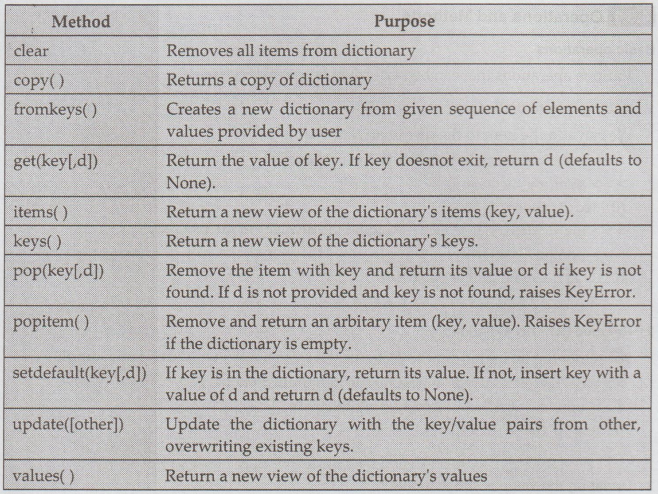
1.
The clear method
This
method removed all the items from the dictionary. This method does not take any
parameter and does not return anything. For example
>>>
my_dictionary={1:'AAA',2:'BBB',3: CCC'} # creation of dictionary
>>>
print(my_dictionary) #display
{1:
'AAA', 2: 'BBB', 3: 'CCC"}
>>>
my_dictionary.clear() #using clear method
>>>
print(my_dictionary) #display
{
}
>>>
2.
The copy method
The
copy method returns the copy of the dictionary. It does not take any parameter
and returns a shallow copy of dictionary. For example
>>>
my_dictionary={1:'AAA',2:'BBB',3:"CCC"}
>>>
print(my_dictionary)
{1:
'AAA', 2: 'BBB', 3: CCC'}
>>>
new_dictionary=my_dictionary.copy()
>>>
print(new_dictionary)
{1:
'AAA', 2: 'BBB', 3: 'CCC'}
>>>
3.
The fromkey method
The
fromkeys() method creates a new dictionary from the given sequence of elements
with a value provided by the user.
Syntax
dictionary.fromkeys(sequences,
value])
The
fromkeys() method returns a new dictionary with the given sequence of elements
as the keys of the dictionary. If the value argument is set, each element of
the newly created dictionary is set to the provided value.
For
example
>>>
keys = {10,20,30}
>>>
values = 'Number'
>>>
new_dict = dict.fromkeys(keys,values)
>>>
print(new_dict)
{10:
'Number', 20: 'Number', 30: 'Number'}
>>>
4.
The get method
The
get() method returns the value for the specified key if key is in dictionary.
This method takes two parameters key and value. The get method can return
either key, or value or nothing.
Syntax
dictionary.get(keys,
value])
For
example
>>>
student={'name':'AAA','roll': 10,'marks':98} #creation of dictionary
>>>
print("Name: ",student.get('name'))
Name:
AAA
>>>
print("roll: ",student.get('roll'))
roll:
10
>>>
print("marks: ",student.get('marks'))
marks:
98
>>> print("Address: ",
student.get('address')) #this key is 'address' is not specified in
the list
Address:
None #Hence it returns none
>>>
5.
The value method
This
method returns the value object that returns view object that displays
the list of values present in the dictionary.
For
example :
>>>
my_dictionary ={'marks 1:99,'marks2:96,'marks3:97}#creating dictionary
>>>
print(my_dictionary.values()) #displaying values
dict_values([99,
96, 97])
>>>
6.
The pop method
This
method The pop() method removes and returns an element from a dictionary having
the given key.
Syntax
pop(keys,
default])
where
key is the key which is searched for removing the value. And default is
the value which is to be returned when the key is not in the dictionary. For
example
my_dictionary={1:'Red',
2:'Blue', 3:'Green'}#creation of dictionary
>>>
val = my_dictionary.pop(1) #removing the element with key 1
>>>
print("The popped element is: ",val)
The
popped element is: Red
>>>
val=my_dictionary.pop(5,3)
#specifying default value. When the specified
key is not present in the list, then the
#default
value is returned.
>>>print("The
popped element using default value is: ",val)
The
popped element using default value is: 3 #default value is returned
>>>
Example
4.3.1 Define dictionary in Python. Do the following
operations on dictionaries
i)
Initialize two dictionaries with key and value pair.
ii)
Compare the two dictionaries with master key list and print missing keys
iii)
Find keys that are in first and not in second dictionary
iv)
Find same keys in two dictionaries
v)
Merge two dictionaries and create a new dictionary using a single expression.
AU
: Dec.-19, Marks 10
Solution
: Dictionary - Refer section 4.3.
i)
d1
= {1:"AAA",2:"BBB",3:"CCC"}
print("Dictionary#1")
print(d1)
print("Dictionary#2")
d2
= {10:"Pune",20:"Mumbai",30:"Chennai"}
print(d2)
ii)
First_Dict
= {"Color": ["Red", "Blue", "Green",
"Yellow"),
"Fruit":
{"Mango", "Banana", "Apple"),
"Flower":
["Rose", "Jasmine", "Lotus", "Lily"),
"Country":
["India", "Japan"]}
Second_Dict
= {"Color": ["Red", "Blue", "Green",
"Yellow"],
"Fruit":
["Mango", "Banana", "Apple"],
"Flower":
["Rose", "Tulip", "Daffodil",),
"City":["Pune",
"Chennai"]}
key_lst=[
]
values_lst=[
]
for
key, value in First_Dict.items() and Second_Dict.items():
if
key in First_Dict.keys() and Second_Dict.keys():
if
key in Second_Dict.keys() and First_Dict.keys() :
continue
else:
key_lst.append(key)
else:
key_lst.append(key)
if
value in First_Dict.values() and Second_Dict.values():
if
value in Second_Dict.values() and First_Dict.values() :
continue
else:
values_lst.append(value)
else:
values_lst.append(value)
for
key, value in Second_Dict.items() and First_Dict.items():
if
key in First_Dict.keys() and Second_Dict.keys():
if
key in Second_Dict.keys() and First_Dict.keys() :
continue
else:
key_lst.append(key)
else:
key_lst.append(key)
if
value in First_Dict.values() and Second_Dict.values():
if
value in Second_Dict.values() and First_Dict.values():
continue
else:
values_lst.append(value)
else:
values_lst.append(value)
print("Missing
Keys: ",key_lst[0],": Missing Values", values_lst[0])
print("Missing
Keys: ",key_lst[1],": Missing Values", values_lst[1])
Output
Missing
Keys: City : Missing Values (Pune', 'Chennai']
Missing
Keys: Country : Missing Values ['India', 'Japan']
>>>
iii)
d1
= {"Color":"Red", "Fruit":"Mango",
"Flower":"Rose", "Country":"India"}
d2
= {"Color": "Red", "Fruit":
"Mango","City":"Pune"}
print(d1.keys()-d2.keys())
iv)
d1
= {"Color": "Red", "Fruit":"Mango",
"Flower":"Rose", "Country":"India"}
d2
= {"Color": "Red", "Fruit":"Mango",
"City":"Pune"}
d3
= [ ]
for
item in d1.keys():
if
item in d2.keys():
d3.append(item)
print(d3)
Output
['Color',
'Fruit']
>>>
v)
dict1
= {1: "AAA", 2:"BBB"}
dict2
= {3: "CCC", 4:"DDD"}
result
= (key:value for d in (dict1, dict2] for key,value in d.items()}
print(result)
Output
{1:
'AAA', 2: 'BBB', 3: 'CCC", 4: 'DDD'}
>>>
Review Questions
1. What is a dictionary in Python ? Give example.
AU: Jan.-18, Marks 4
2. Appraise the operations for dynamically manipulating
dictionaries.
AU: Jan.-18, Marks 12
Problem Solving and Python Programming: UNIT IV: Lists, Tuples, Dictionaries : Tag: Engineering Python : Python Programming - Dictionaries
Related Topics
Related Subjects
Problem Solving and Python Programming
GE3151 1st Semester | 2021 Regulation | 1st Semester Common to all Dept 2021 Regulation
